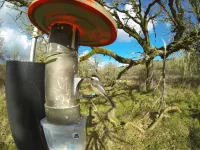(Press-News.org) A new discovery in rats shows that the brain responds differently in immersive virtual reality environments versus the real world. The finding could help scientists understand how the brain brings together sensory information from different sources to create a cohesive picture of the world around us. It could also pave the way for "virtual reality therapy" for learning and memory-related disorders ranging including ADHD, Autism, Alzheimer's disease, epilepsy and depression.
Mayank Mehta, PhD, is the head of W. M. Keck Center for Neurophysics and a professor in the departments of physics, neurology, and electrical and computer engineering at UCLA. His laboratory studies a brain region called the hippocampus, which is a primary driver of learning and memory, including spatial navigation. To understand its role in learning and memory, the hippocampus has been extensively studied in rats as they perform spatial navigation tasks.
When rats walk around, neurons in this part of the brain synchronize their electrical activity at a rate of 8 pulses per second, or 8 Hz. This is a type of brain wave known as the "theta rhythm," and it was discovered more than six decades ago.
Disruptions to the theta rhythm also impair the rat's learning and memory, including the ability to learn and remember a route through a maze. Conversely, a stronger theta rhythm seems to improve the brain's ability to learn and retain sensory information.
Therefore, researchers have speculated that boosting theta waves could improve or restore learning and memory functions. But until now, nobody has been able to strengthen these brain waves.
"If that rhythm is so important, can we use a novel approach to make it stronger?" asks Dr. Mehta. "Can we retune it?"
Damage to neurons in the hippocampus can interfere with people's perception of space - "why Alzheimer's disease patients tend to get lost," says Dr. Mehta. He says he suspected that the theta rhythm might play a role in this perception. To test that hypothesis, Dr. Mehta and his colleagues invented an immersive virtual reality environment for the rats that was far more immersive than commercially available VR for humans.
The VR allows the rats to see their own limbs and shadows, and eliminates certain unsettling sensations such as the delays between head movement and scene changes that can make people dizzy.
"Our VR is so compelling," Dr. Mehta says, "that the rats love to jump in and happily play games."
To measure the rats' brain rhythms, the researchers placed tiny electrodes, thinner than a human hair, into the brain among the neurons.
"It turns out that amazing things happen when the rat is in virtual reality," says Dr. Mehta. "He goes to the virtual fountain and drinks water, takes a nap there, looks around and explores the space as if it is real."
Remarkably, Dr. Mehta says, the theta rhythm becomes considerably stronger when the rats run in the virtual space in comparison to their natural environment
"We were blown away when we saw this huge effect of VR experience on theta rhythm enhancement," he says.
This discovery suggests that the unique rhythm is an indicator of how the brain discerns whether an experience is real or simulated. For instance, as you walk toward a doorway, the input from your eyes will show the doorway getting larger. "How do I know I took a step and it's not the wall coming at me?" Dr. Mehta says.
Answer: The brain uses other information, such as the shift of balance from one foot to the other, the acceleration of your head through space, the relative changes in the positions of other stationary objects around you, and even the feeling of air moving against your face to decide that you are moving, not the wall.
On the other hand, a person "moving" through a virtual reality world would experience a very different set of stimuli.
"Our brain is constantly doing this, it's checking all kinds of things," Dr. Mehta says. The different theta rhythms, he says, may represent different ways that brain regions communicate with each other in the process of gathering all this information.
When they looked closer, Dr. Mehta's team also discovered something else surprising. Neurons consist of a compact cell body and long tendrils, called dendrites, that snake out and form connections with other neurons. When the researchers measured activity in the cell body of a rat brain experiencing virtual reality, they found a different electrical rhythm compared with the rhythm in the dendrites. "That was really mind blowing," Dr. Mehta said. "Two different parts of the neuron are going in their own rhythm."
The researchers dubbed this never-before-seen rhythm "eta." It turned out this rhythm was not limited to the virtual reality environment: with extremely precise electrode placement, the researchers were then able to detect the new rhythm in rats walking around a real environment. Being in VR, however, strengthened the eta rhythm - something no other study in the past sixty years has been able to do so strongly, either using pharmacological tools or otherwise, according to Dr. Mehta.
Previous studies have shown that the precise frequency of the rhythm makes a big difference to neuroplasticity, he says, just as the precise pitch of a musical instrument is critical for creating the right melody. This opens up an unprecedented opportunity to design VR therapy that can retune and boost brain rhythms and as a way to treat learning and memory disorders.
"This is a new technology that has tremendous potential," he says. "We have entered a new territory."
INFORMATION:
An international team of astronomers has observed the first example of a new type of supernova. The discovery, confirming a prediction made four decades ago, could lead to new insights into the life and death of stars. The work is published June 28 in Nature Astronomy.
"One of the main questions in astronomy is to compare how stars evolve and how they die," said Stefano Valenti, professor of physics and astronomy at the University of California, Davis, and a member of the team that discovered and described supernova 2018zd. "There are many links still missing, so this is very exciting."
There ...
NEW YORK, NY (June 28, 2021)--In the first analysis of its kind, researchers at Columbia University Vagelos College of Physicians and Surgeons and several other institutions have linked distinct patterns of genetic mutations with obsessive-compulsive disorder (OCD) in humans.
The work, published online June 28 in Nature Neuroscience, confirms the validity of targeting specific genes to develop new OCD treatments and points toward novel avenues for studying this often debilitating condition.
OCD, which affects 1% to 2% of the population, often runs in families and genes are known to play a large role in determining who develops the disease. However, the identity of many OCD genes remains unknown.
"Many neurological diseases are ...
Slow earthquakes are long-period earthquakes that are not so dangerous alone, but are able to trigger more destructive earthquakes. Their origins lie in tectonic plate boundaries where one plate subsides below another. Though the causal mechanism is already known, there has been a lack of data to accurately model the life cycle of slow earthquakes. For the first time, researchers use deep-sea boreholes to gauge pressures far below the seafloor. They hope data from this and future observations can aid the understanding of earthquake evolution.
The surface of the Earth lies upon gargantuan ...
New York, NY--June 28, 2021--Predicting what someone is about to do next based on their body language comes naturally to humans but not so for computers. When we meet another person, they might greet us with a hello, handshake, or even a fist bump. We may not know which gesture will be used, but we can read the situation and respond appropriately.
In a new study, Columbia Engineering researchers unveil a computer vision technique for giving machines a more intuitive sense for what will happen next by leveraging higher-level associations between people, animals, and objects.
"Our algorithm is a step toward machines being able to make better predictions about human behavior, and ...
Sixteen of the 146 health-related All-Party Parliamentary Groups (APPGs) in the Houses of Parliament (UK) received over a £1 million in payments from 35 pharmaceutical companies between 2012-2018 according to a new study.
The researchers behind the analysis from the University of Bath's Centre for the Analysis of Social Policy suggest their findings reveal a worrying lack of transparency over payments received and potential conflicts of interests towards public policy.
Through their research they extracted details from 6,624 entries about funding ...
Experts estimate more than 6 million Americans are living with Alzheimer's dementia. But a recent study, led by the University of Cincinnati, sheds new light on the disease and a highly debated new drug therapy.
The UC-led study, conducted in collaboration with the Karolinska Institute in Sweden, claims that the treatment of Alzheimer's disease might lie in normalizing the levels of a specific brain protein called amyloid-beta peptide. This protein is needed in its original, soluble form to keep the brain healthy, but sometimes it hardens into "brain stones" or clumps, called amyloid plaques.
The study, which appears in the journal EClinicalMedicine (published by the Lancet), comes on the heels of the FDA's conditional approval of a new medicine, aducanumab, that ...
CORVALLIS, Ore. - Oregon State University researchers have some good news for the well-meaning masses who place bird feeders in their yards: The small songbirds who visit the feeders seem unlikely to develop an unhealthy reliance on them.
"There's still much we don't know about how intentional feeding might induce changes in wild bird populations, but our study suggests that putting out food for small birds in winter will not lead to an increased dependence on human-provided food," said Jim Rivers, an animal ecologist with the OSU College of Forestry.
Findings from the research, which looked at black-capped chickadees outfitted with radio frequency identification tags, ...
New York, NY (June 28, 2021) - Patients with a type of blood cancer called multiple myeloma had a widely variable response to COVID-19 vaccines--in some cases, no detectable response--pointing to the need for antibody testing and precautions for these patients after vaccination, according to a study that will be published in Cancer Cell this week.
Mount Sinai researchers found that multiple myeloma patients mount variable and sometimes suboptimal responses after receiving the Pfizer-BioNTech or Moderna COVID-19 vaccines. Almost 16 percent of these patients developed no detectible antibodies after both vaccine doses. These findings may be relevant to other cancer patients undergoing treatment and to immunocompromised patients.
"This study ...
Did you know chocolate comes from cocoa beans grown in some of the most biodiverse tropical landscapes on the planet? The cocoa tree (Theobroma cacao) is farmed within biodiversity hotspots of West Africa, South America, and Southeast Asia. Cocoa was traditionally grown under a canopy of native trees that provided habitat for birds and other wildlife. However, pressure to increase cocoa production has pushed many farmers to clear forest and eliminate the shade trees on their farms.
An estimated 2-3 million hectares of tropical forest were converted to cocoa from 1988-2008 with severe consequences for biodiversity. Unsustainable cocoa monocultures (agricultural ...
Multi-business firms have flexibility advantages over single-business rivals because they have the option to redeploy resources across businesses. This flexibility, it has been assumed without empirical evidence, is purported to inspire quicker exits from markets.
A 2017 survey revealed that 70 percent of corporate executives expected to make at least one divestment in the subsequent two years, with the primary motive being strategic realignment of portfolios as non-core assets are shed. A large number of academic studies have established that parent firms tend ...




